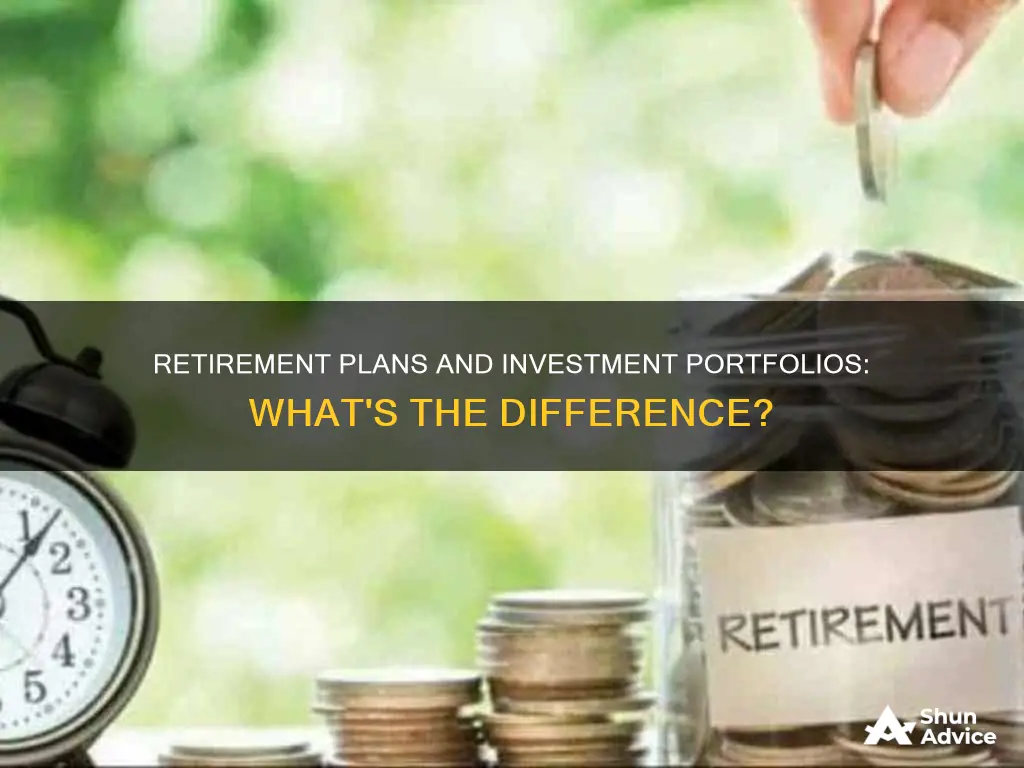
Retirement plans and investment portfolios are not the same thing, but they are closely related. A retirement plan is a type of financial plan that helps individuals save and invest for their retirement years. On the other hand, an investment portfolio is a collection of various investments held by an individual or entity, which can include retirement accounts.
Retirement plans typically involve contributing a portion of one's income to a tax-advantaged account, such as a 401(k) or an Individual Retirement Account (IRA), over a long period. These contributions may be matched by an employer, and the funds are usually invested in a diversified portfolio of stocks, bonds, mutual funds, and other assets to grow over time.
An investment portfolio, on the other hand, is a broader concept that includes all the investments held by an individual or entity. This can include retirement accounts, such as 401(k)s and IRAs, but also taxable brokerage accounts, real estate, and other types of investments. The goal of an investment portfolio is to generate returns and achieve specific financial objectives, which may include funding retirement.
While retirement plans are specifically designed for saving and investing for retirement, investment portfolios can have a wider range of purposes, such as generating income, capital appreciation, or achieving specific financial goals. Additionally, investment portfolios can be more flexible in terms of the types of investments they hold and the level of risk they take on.
In summary, a retirement plan is a type of financial strategy focused on saving and investing for retirement, while an investment portfolio is a collection of investments that can include retirement accounts but may also have other purposes and goals.
| Characteristics | Values |
|---|---|
| Definition | Retirement plans are designed to help investors increase the value of their investments over long periods of time. |
| Types of Retirement Plans | Defined benefit plans, defined contribution plans, 401(k)s, 403(b)s, IRAs, SEP IRAs, solo 401(k)s, SIMPLE IRAs, profit-sharing plans |
| Investment Options | Stocks, mutual funds, bonds, cash, annuities, exchange-traded funds (ETFs), individual stocks and bonds, dividend stocks, certificates of deposit (CDs), target-date funds, robo-advisors, etc. |
| Investment Strategy | Focus on growth investments as a young investor, then shift towards income and capital preservation as you near retirement. |
| Management | Active vs. passive management. Active management results in higher investment returns but higher transaction fees. |
What You'll Learn

Retirement plans vs investment portfolios: what's the difference?
Retirement plans and investment portfolios are not the same thing, but they are closely related. Both are designed to help you save for retirement, but they differ in terms of their structure, flexibility, and tax treatment. Here is a detailed comparison between the two:
Definition
An investment portfolio is a collection of various investments held by an individual or entity. It encompasses all the investments across different accounts, such as employer-sponsored plans (e.g., 401(k)s), IRAs (traditional and Roth), taxable brokerage accounts, cash in savings accounts, and even real estate. The goal of an investment portfolio is to generate returns and grow your wealth over time, including for retirement.
On the other hand, a retirement plan is a structured approach to saving and investing for retirement. It involves selecting appropriate accounts, such as 401(k)s, IRAs, or employer-sponsored plans, and contributing to them regularly. Retirement plans may also include strategies for maximising tax benefits and ensuring a steady stream of income during retirement.
Flexibility and Control
Investment portfolios offer more flexibility and control over your investments. You can choose from a wide range of investment options, including stocks, bonds, mutual funds, ETFs, and alternative investments. You can tailor your portfolio to match your risk tolerance, investment horizon, and financial goals.
Retirement plans, especially employer-sponsored plans, may have more limited investment options. They often provide a list of pre-selected funds or investment choices within the plan. However, you still have some control over how you allocate your contributions among these choices.
Tax Treatment
The tax treatment of investment portfolios and retirement plans can vary. With investment portfolios, you may have taxable accounts, tax-deferred accounts (e.g., 401(k)s, traditional IRAs), or tax-free accounts (e.g., Roth IRAs). The tax implications depend on the specific types of investments and accounts you choose.
Retirement plans, especially employer-sponsored plans like 401(k)s, often offer tax advantages. Contributions to traditional 401(k)s, for example, are made with pre-tax dollars, reducing your taxable income for the year. Roth accounts, on the other hand, are funded with after-tax dollars but offer tax-free withdrawals in retirement.
Management
Investment portfolios can be self-managed or managed by financial advisors or robo-advisors. You have the flexibility to choose the level of involvement and expertise you want in managing your portfolio.
Retirement plans, especially employer-sponsored plans, are often managed by the plan administrator or a separate financial institution. They handle the administrative tasks, such as statements and disclosures, and provide a range of investment options for participants to choose from.
In summary, both investment portfolios and retirement plans play a crucial role in saving for retirement. Investment portfolios offer more flexibility and control over your investments, while retirement plans provide a structured approach with potential tax advantages. It is important to understand the differences between the two and how they can work together to help you achieve your retirement goals.
GME: The People's Investment
You may want to see also

What are the pros and cons of each?
A retirement plan is not the same as an investment portfolio. A retirement plan is a type of financial arrangement that aims to provide individuals with income and financial security during their retirement years. On the other hand, an investment portfolio is a collection of financial investments, such as stocks, bonds, real estate, and cash, which can be used for various financial goals, including retirement.
Retirement Plans:
Retirement plans can vary, but some common types include pensions, 401(k)s, and IRAs. The pros and cons will depend on the specific type of retirement plan:
Pros of Retirement Plans:
- Pensions, or defined benefit plans, are easy to manage and are fully funded by employers, providing a fixed monthly benefit.
- Defined contribution plans, such as 401(k)s, allow employees to save on a pre-tax basis, reducing their tax liability.
- Retirement plans often include matching contributions from employers, which can boost retirement savings.
- Retirement plans provide tax advantages, such as tax-deferred growth or tax-free withdrawals.
- Retirement plans can help individuals save for the long term and achieve financial security during retirement.
Cons of Retirement Plans:
- Defined benefit plans are becoming less common as they are expensive for employers.
- Retirement plans may not be portable, meaning individuals may lose benefits if they change jobs.
- Defined contribution plans place the investment risk on the individual, and there is no guarantee of adequate savings for retirement.
- Some retirement plans, like 401(k)s, may have limited investment options or high fees that can eat into returns.
Investment Portfolios:
Investment portfolios can be customized to an individual's financial goals, risk tolerance, and time horizon.
Pros of Investment Portfolios:
- Investment portfolios offer flexibility and control over investment choices, allowing individuals to tailor their portfolio to their specific goals and risk tolerance.
- Portfolios can be diversified across various asset classes, such as stocks, bonds, real estate, and commodities, to reduce risk and improve returns.
- Investment portfolios can be managed by the individual or a financial professional, providing the opportunity for active or passive management.
- Investment portfolios can be used for various financial goals, including retirement, and can be adjusted as goals and circumstances change.
Cons of Investment Portfolios:
- Managing an investment portfolio requires financial knowledge and time; improper management can lead to losses.
- Investment portfolios are subject to market risk, and the value of investments can fluctuate, impacting an individual's financial goals.
- Diversification does not guarantee against loss, and even well-diversified portfolios can experience negative returns.
- Investing typically requires a long-term commitment, and early withdrawal of funds can result in penalties and taxes.
Chase Invest: Understanding Dividend Payments
You may want to see also

How do I choose the right one for me?
Choosing between a retirement plan and an investment portfolio depends on your age, risk tolerance, and financial goals. Here are some factors to consider when deciding which option is right for you:
- Age: If you are younger, you may want to take on more risk with your investments as you have time to recover from any market downturns. As you get older, you may want to shift your focus to capital preservation and income generation.
- Risk tolerance: Consider how comfortable you are with taking risks. If you are risk-averse, you may prefer a more conservative investment strategy that focuses on capital preservation. If you are comfortable with risk, you may be willing to invest in more volatile stocks or other growth investments.
- Financial goals: What are your financial goals for retirement? Do you want to maintain your current lifestyle, or do you want to grow your wealth? Different investment options will help you achieve different goals.
- Time horizon: How long do you have until retirement? If you are many years away from retirement, you may have more time to ride out market fluctuations and take on more risk. If retirement is just around the corner, you may want to focus on more stable and conservative investments.
- Income needs: Consider your current income and how much you need to save for retirement. This will help you determine how much risk you can take on with your investments.
- Diversification: Diversifying your investments can help reduce risk and increase potential returns. Consider investing in a variety of asset types, industries, company sizes, styles, and geographies.
- Start early: The power of compounding means that starting to save and invest early in your career can significantly grow your retirement savings over time.
- Rebalance your portfolio: As you age, your investment goals, risk tolerance, and time horizon will change. Periodically reevaluate your portfolio to ensure it still aligns with your goals and make adjustments as needed.
- Seek professional advice: Consider consulting a financial advisor or using a robo-advisor to help you choose the right investments and create a plan that fits your needs.
Understanding the Present Value Advantage
You may want to see also

What are some common types of retirement plans?
Retirement plans are designed to help investors increase the value of their investments over long periods of time. There are various types of retirement plans, including traditional and non-traditional options. Here are some common types of retirement plans:
- 401(k) Plans: These are defined contribution plans where employees contribute a portion of their paycheck to their retirement account. Sometimes, employers match these contributions up to a certain amount. Employees have access to the funds upon retirement.
- Individual Retirement Accounts ( IRAs): These can be traditional or Roth IRAs. Traditional IRAs allow tax deductions on contributions, while Roth IRAs offer tax-free withdrawals in retirement. Both have contribution restrictions and penalties for early withdrawals.
- Pension Plans: Also known as defined benefit plans, these are retirement plans provided by employers. The retirement benefits are calculated based on factors like age, salary, and length of employment. Pension plans are becoming less common due to higher costs for employers.
- Employee Stock Ownership Plans ( ESOPs): These are defined contribution plans where the primary investments are in employer stock.
- Cash Balance Plans: These are a type of defined benefit plan that defines the benefit in terms of a stated account balance, combining features of defined benefit and defined contribution plans. They provide a fixed payout upon retirement and are protected by federal insurance.
- Profit-Sharing Plans: These plans allow employers to contribute a portion of their profits to employee retirement accounts. They can be set up in addition to other qualified retirement plans and are voluntary.
- SEP Plans: Simplified Employee Pension plans are retirement accounts established by small business owners or self-employed individuals for themselves and their employees. Contributions are tax-deductible, and the plans have higher contribution limits than traditional IRAs.
- SIMPLE IRA Plans: Savings Incentive Match Plans for Employees are set up by employers, who are required to contribute on behalf of employees. Employees are not required to contribute, but there are penalties for early withdrawals.
These are just a few examples of common retirement plans. Each plan has its own benefits, drawbacks, contribution limits, tax implications, and eligibility requirements. It's important to carefully consider these factors when choosing a retirement plan to ensure it aligns with your financial goals and risk tolerance.
Networking: Your Secret Weapon for Success
You may want to see also

How do I build an investment portfolio for retirement?
An investment portfolio is the sum total of all your investments across various accounts. It grows throughout your working years so that it can provide you with the income you need to maintain your lifestyle during retirement.
Start early
The power of compounding means that the earlier you start saving and investing, the more your money can grow over time.
Diversify your portfolio
Diversification helps to reduce risk and increase the potential for overall return. Diversification can take different forms depending on your age and risk tolerance. In your 20s, you may want to invest in different types of equities (large-, mid-, and small-cap stocks and funds, and real estate). As you get older, you may want to move into more conservative sectors like corporate bonds and preferred stock offerings.
Choose active or passive portfolio management
Active management tends to result in higher investment returns but also higher transaction fees. Passive management, on the other hand, tends to have lower fees but may not perform as well as actively managed portfolios.
Decide on your risk tolerance
Your risk tolerance refers to the amount of volatility in your investments that you are willing to accept. Generally, the further you are from retirement, the more risk you can take on as you have more time to recover from market downturns.
Choose your investments
The most common investment types for retirement portfolios include stocks, bonds, mutual funds, exchange-traded funds (ETFs), and annuities.
- Stocks: These offer potential for long-term appreciation and some provide income in the form of dividends. Examples of growth stocks include Tesla, Amazon, Facebook, Apple, and Microsoft. Value stocks are considered underpriced and include companies like Johnson & Johnson, Coca-Cola, and Procter & Gamble. Dividend stocks provide regular income and include companies that consistently increase dividends annually.
- Bonds: These are debt instruments that pay interest income and can be issued by governments, municipalities, or corporations. U.S. government bonds (Treasurys) are considered the safest, followed by municipal and corporate bonds.
- Mutual Funds and ETFs: Mutual funds are actively managed and tend to have higher fees, while ETFs are passively managed and traded on exchanges like stocks, with lower share prices.
- Annuities: Annuities are contracts with insurance companies that guarantee future income, either as a lump sum or a series of payments.
Choose your investment accounts
There are several types of investment accounts that can be used for retirement, each with different tax treatments and restrictions:
- Taxable accounts: These are available to any adult with a Social Security number and incur taxes on interest, dividends, and realized capital gains.
- Tax-deferred accounts: These accounts postpone tax liability and allow contributions with pre-tax funds. Examples include Traditional IRAs and 401(k)s, which have withdrawal restrictions and penalties for early withdrawals.
- Roth accounts: These accounts allow tax-free interest, dividends, and realized capital gains if certain conditions are met, including using after-tax money and waiting until you are 59 1/2 years old to withdraw.
- Health Savings Accounts (HSAs): HSAs are oriented towards healthcare expenses but can be used for healthcare costs in retirement tax-free.
Consult a financial advisor
If you are unsure about how to build your investment portfolio, consider consulting a financial advisor or using a robo-advisor, which is a low-cost digital platform that uses algorithms to manage your investments.
VP Investments: Milwaukee's Hotspots for Financial Opportunities
You may want to see also
Frequently asked questions
A retirement plan is an account specifically designed to help individuals save for retirement. Examples include 401(k)s, IRAs, and pension plans.
An investment portfolio is a collection of investments held by an individual or entity. It can include various assets such as stocks, bonds, mutual funds, and real estate.
No. A retirement plan is a type of investment account, but it is not the same as an investment portfolio. A retirement plan is just one component of an individual's overall investment portfolio.
When building an investment portfolio for retirement, it is important to consider your risk tolerance, investment objectives, and time horizon. A well-diversified portfolio typically includes a mix of stocks, bonds, and other assets. It is also crucial to start saving and investing as early as possible to take advantage of compound interest.







